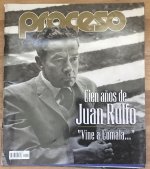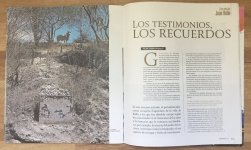And from the New York Times, a review of the latest translation into English
A Masterpiece That Inspired Gabriel García Márquez to Write His Own
For decades, Juan Rulfo’s novel, “Pedro Páramo,” has cast an uncanny spell on writers. A new translation may bring it broader appeal.
By Valeria Luiselli
Valeria Luiselli is the author of several award-winning books, among them “Lost Children Archive.” She teaches at Bard College and Harvard University.
Nov. 29, 2023
When you purchase an independently reviewed book through our site, we earn an affiliate commission.
Readers of Latin American literature may have heard one of the many versions of this story:
It is 1961 and Gabriel García Márquez has just arrived in Mexico City, penniless but full of literary ambition, trying desperately to work on a new novel. One day, he is sitting in the legendary Café La Habana, where Fidel Castro and Che Guevara were said to have plotted the Cuban Revolution. Julio Cortázar walks in, carrying a copy of Juan Rulfo’s novel “Pedro Páramo.” With a swift gesture, as if he’s dealing cards, Cortázar throws the book on García Márquez’s table. “Tenga, pa que aprenda,” he says. “Read this and learn.”
That night, García Márquez reads the novel in a single, feverish, sleepless sitting. He is so deeply haunted by this slim book, set in a rural village full of ghosts and echoes from the past, that he reads it again that same night, and starts memorizing it. The next day, he is finally able to begin writing “One Hundred Years of Solitude.”
This is the version I heard when I was a young student — a version, it turns out, that contains some errors. The place was not Café La Habana but García Márquez’s modest apartment, and it was not Cortázar but Álvaro Mutis who gave him the book. But the kernel of this literary legend — the bedazzlement, the rapacious reading, the swell of inspiration — remains true.
What I like about the story, which García Márquez recounts in a 1980 foreword that appears in a new translation of PEDRO PÁRAMO (Grove, 129 pp., paperback, $17), is not what it says about García Márquez the writer: his photographic and phonographic memory, his baroque literary fervor and his almost humble confession that it was this compact novel that showed him a way back into writing and ultimately made possible his masterpiece. What I like about it is what it says about García Márquez the reader, and more widely, what it says about the spell Rulfo’s book casts on so many of its admirers.
“Pedro Páramo,” first published in Mexico in 1955, often produces a feverish response. Jorge Luis Borges said it was one of the greatest works of literature ever written. Susan Sontag called it one of the masterpieces of the 20th century. Enrique Vila-Matas has said that it is the “perfect novel.” Roberto Bolaño’s “2666” would probably not exist without it. The book shows its readers how to read all over again, the same way “The Waste Land” or “Ulysses” does, by bending the rules of literature so skillfully, so freely, that the rules must change thereafter.
I first read the novel in high school, in Mexico, for a class called Reading, Redaction and Initiation Into Documentary Investigation. I was 14 or 15, and it was not love at first sight. The class was as stale as its name — it is astonishing how literary education often goes out of its way to bore readers out of the pleasure of books — and I understood nothing.
It was only the second or third time I read it, while at an international boarding school in India, that I began to understand and appreciate what Rulfo had done. I pored over it with a group of Latin American students, all of us around 16 or 17. We read it the way difficult things should be read: slowly, collectively, out loud and with a pencil in hand. We had different accents — Argentinian, Dominican, Costa Rican, Spanish, Bolivian — yet Rulfo’s unique use of the vernacular from the Altos de Jalisco seemed to resonate perfectly with the many inflections of our group.
We could not have articulated it properly back then, but I am sure we all felt it, something timeless and boundless in this seemingly ultra-local story of peasants and moguls during the Mexican Revolution. It is a story of all revolutions: the landless against the landlords, the dispossessed against the powerful. It is a story of usurpation, extraction and sexual violence. Of stealing land, settling it and exploiting it and its people. In other words, it is a story of nation-building in the Americas.
But at its core, “Pedro Páramo” is a tale of two journeys, or perhaps one journey that unfolds into two. The first is a linear one driven by a Telemachean quest: a man searching for his missing father. The narrator, Juan Preciado, goes to his parents’ hometown after his mother dies, seeking his long-estranged father, Pedro Páramo. He plans to demand reparations. But what he finds is a ghost town. Then he dies. (This is not a spoiler; the story continues after his death as if nothing really happened.) The second journey is Dantesque: a spiraling descent into a kind of underworld. But unlike Dante’s mathematically plotted inferno, with its concentric circles and somewhat navigable geography, Rulfo’s is largely sensory, densely packed with sounds and their endless reverberations.
Many Latin American readers know the opening sentence of the novel by heart: “Vine a Comala porque me dijeron que acá vivía mi padre, un tal Pedro Páramo.” From the beginning, we find ourselves in an unstable space-time that we will question and redefine as we move through the novel. For English-language readers, key differences in two translations of the opening line will help bring this ambiguity to light. The 1994 translation, by Margaret Sayers Peden, reads: “I came to Comala because I had been told that my father, a man named Pedro Páramo, lived there.” The most recent translation, by Douglas J. Weatherford, is: “I came to Comala because I was told my father lived here, a man named Pedro Páramo.” Just as the exchange of “here” for “there” radically changes the story’s spatiality (where the narrator is speaking), the use of “was told” — less removed than “had been told” — shifts its temporality (when the narration happens).
Nothing can fall into place in a novel if the author does not have control over its sense of time, be it linear or fractured. In novels of fractured time, the sequence of events must be governed by a logic of its own, one justified by the book’s central questions. Throughout “Pedro Páramo” — in which a central concern is how the world of the living haunts the world of the dead, and not vice versa, as with most ghost stories — time ebbs and flows in a kind of tidal pattern. It is not quite circular, because circles are closed circuits, but the cadence is similar to something cyclical, to the uprush and backwash of water breaking over sand, over and over again. The dead, tormented by lives they can no longer participate in but which their memories replay, over and over again, produce a steady undercurrent of murmurs, laments, mutterings, chatter, whispers, quiet confessions.
If where and when we are in “Pedro Páramo” is constantly shifting, then sound is the swift and sinuous vehicle that carries us through it. For a class I taught this fall, I asked my students to find the many sonic markers in the novel. (It was a fun experiment, and we shared the results with the sound designers of a forthcoming “Pedro Páramo” film. They wrote back to say they were inspired by our sound lists and wanted to credit the students.)
I was astonished to see how much of the novel is composed of aural details. Still air shattered by doves’ flapping wings. Hummingbirds whirring among jasmine bushes. Laughter. A tap of knuckles on the confessional window. A church clock ringing out the hours, “one after another, one after another, as if time had contracted.” Also sounds we cannot hear, but can almost imagine: “the earth rotating on rusted hinges, the trembling of an ancient world pouring out its darkness.” And of course, the myriad sounds of rain.
It rains a lot in “Pedro Páramo.” And it is usually water that marks the book’s space-time transitions. The dead become restless when it rains. “The moisture must have reached her so she’s tossing in her sleep,” one character says of a woman buried in a sepulcher. The dead start listening, and like seeds underground they begin to stir in disquiet, until they burst into conversation. One of my students called it “seepage”: As rain softens the soil, the voices in “Pedro Páramo” are able to seep through it and become audible. There’s an inevitable elusiveness to a novel with a narrative structure pieced together from muffled voices in muddy waters, but it is the kind of elusiveness that has us leaning in, so as to listen better.
[continued in next post]



